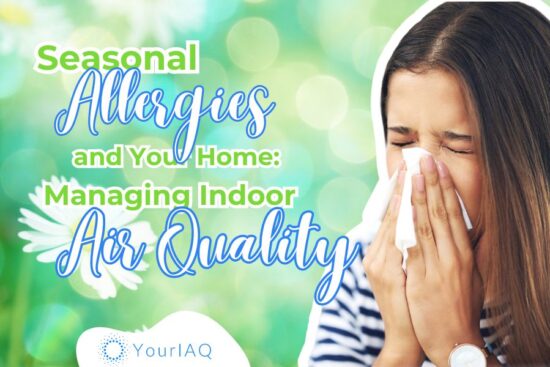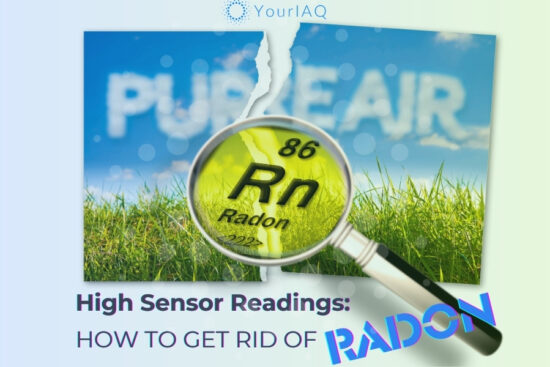
Welcome to the evolving world of indoor air quality (IAQ) and home automation—a realm where health meets technology. In our day-to-day lives, the air we breathe indoors plays a critical role in overall well-being. Surprisingly, the air within our homes and offices can harbor more pollutants than the air outside, affecting health in ways we often overlook.
This is where home automation steps in, revolutionizing the ways we monitor and manage indoor environments. Integrating home air quality monitor automation into living spaces brings real-time data and control, ensuring the air we breathe is not just invisible but invigorating. This blend of technology and health consciousness is quickly becoming an essential part of creating safer, healthier homes in an increasingly digital world.
The Health Risks of Poor Indoor Air Quality
IAQ is an aspect of environmental health that often goes unnoticed, yet significantly impacts our daily lives. Contrary to common belief, the air inside homes and workplaces can be more polluted than outdoor air. This indoor air pollution results primarily from two factors: limited ventilation, which traps contaminants indoors, and the presence of unhealthy indoor pollutants. According to the Environmental Protection Agency (EPA), everyday activities such as cooking, cleaning, or use of certain building materials and furniture can release pollutants like volatile organic compounds (VOCs), particulate matter, and other harmful substances into our indoor environment.
The health risks associated with poor IAQ are manifold and can be severe. The World Health Organization links poor indoor air quality to a range of health problems, from acute conditions like headaches and dizziness to chronic illnesses such as asthma, heart disease, and lung cancer. Add to these risks the fact that people typically spend a significant portion of their time indoors, increasing their exposure to indoor air pollutants. Children, the elderly, and those with preexisting health conditions are particularly vulnerable to these negative health effects. Thus, mitigating sources of indoor air pollution is crucial for maintaining a healthy living environment.
Technological Advancements in Air Quality Monitoring
Significant technological advancements in air quality monitoring transform our ability to understand and control the air we breathe indoors. One of the most notable developments is the advent of smart air quality sensors. These sophisticated devices are capable of detecting a wide range of pollutants, including VOCs, mold, carbon dioxide, and even humidity levels. They offer real-time monitoring and are increasingly sensitive and accurate, providing detailed insights into any indoor environment.
Integrating these advanced air quality monitoring technologies into home automation systems opens up a new realm of possibilities for maintaining optimal indoor environments. Smart sensors can seamlessly connect to other home automation devices via IoT (Internet of Things) platforms. This integration of data allows for automated responses to changes in air quality. For instance, if a sensor detects high levels of pollutants, it can trigger air purifiers, adjust HVAC systems, or even control windows and ventilation systems to improve air circulation. This not only ensures a consistently healthy indoor air quality but also enhances energy efficiency and comfort. The ability to monitor and adjust indoor air quality remotely through smartphones or other devices adds an extra layer of convenience, making it easier than ever to maintain a healthy home environment.
Smart Home Connectivity for IAQ Management
The trend of integrating various smart home devices for improved IAQ management is gaining momentum in the realm of home automation. This integration represents a significant shift towards creating healthier, more efficient living environments. By connecting devices such as smart air quality monitors, HVAC systems, air purifiers, and even smart windows, homeowners can achieve a more comprehensive and automated approach to managing air quality. These systems work in concert, using real-time data from air quality sensors to adjust settings on other devices, ensuring optimal air conditions throughout the home.
Platforms like Apple HomeKit, Google Home, and Amazon Alexa are at the forefront of this integration, offering centralized control for a range of compatible devices. These platforms allow users to set up routines and automations based on air quality readings. For example, if a sensor detects high humidity levels, it can automatically activate a dehumidifier or adjust the air conditioning settings. Community contributions in this field are also noteworthy, with open-source platforms like Home Assistant enabling tech-savvy individuals to create custom integrations and automations. These community-driven platforms often support a wider range of devices and offer more flexibility for personalized setups. The collaboration and innovation in this space are rapidly expanding the possibilities for smart home connectivity, making IAQ management more accessible and effective than ever before.
Personalized Health Management in Smart Homes
Smart home technology increasingly plays a pivotal role in personalized health management, particularly in the realm of IAQ. By leveraging interconnected devices and advanced sensors, smart homes can now monitor and respond to environmental factors that directly impact residents’ health. For instance, smart air quality monitors continuously assess levels of pollutants like VOCs, particulate matter, and allergens. When these monitors detect poor air quality, they can automatically activate air purifiers or adjust HVAC systems to filter out contaminants, thus maintaining a healthier indoor environment.
Furthermore, this technology can be tailored to individual health needs. For people with respiratory conditions like asthma or allergies, smart homes can be programmed to maintain even stricter air quality standards. They also provide personalized alerts and recommendations, such as suggesting the best times to ventilate the house or when to replace air filters.
The integration with wearable health devices adds another layer of personalization. These wearables can track physiological responses to air quality, like changes in heart rate or respiratory patterns, and communicate with the home automation system to adjust the environment accordingly. This synergy between smart home technology and personal health devices creates a living space that not only reacts to environmental changes but also adapts to the unique health requirements of its inhabitants, paving the way for a new era of personalized health management in the comfort of one’s home.
Intelligent Energy Management and IAQ
The intersection of intelligent energy management and IAQ in smart homes represents a crucial aspect of modern living, where comfort, health, and sustainability converge. Smart homes equipped with advanced sensors and AI-driven systems are adept at optimizing energy use while maintaining or improving air quality. For instance, smart HVAC systems can adjust heating and cooling based on real-time air quality data, ensuring that energy is not wasted on over-conditioning spaces. This not only conserves energy but also prevents the excessive circulation of pollutants.
Efficient energy use in smart homes directly impacts air quality by reducing the need for constant heating, cooling, and air circulation, which can sometimes contribute to the spread of indoor pollutants. Smart thermostats and ventilation systems work in tandem to maintain optimal temperature and humidity levels, conditions that are essential for minimizing the presence of allergens and mold.
Additionally, these systems can be programmed to use energy more during off-peak hours, reducing the home’s carbon footprint and its impact on outdoor air pollution, which can infiltrate indoor spaces. By intelligently managing energy consumption, smart homes not only contribute to a healthier indoor environment but also play a part in the broader context of environmental conservation and sustainability.
Home Robotics in IAQ Management
The emerging role of home robotics in monitoring and improving IAQ marks a significant advancement in smart home technology. These robots, equipped with sensors and AI algorithms, are transforming the way we manage and maintain air quality in our living spaces. Unlike static sensors, home robotics can move around different areas of the house, providing a more comprehensive and dynamic assessment of air quality. They can detect a range of pollutants, such as VOCs, particulate matter, and allergens, in various locations, offering a detailed analysis of the air we breathe.
Moreover, robots can take proactive measures to improve IAQ. For instance, robotic devices equipped with built-in air purifiers can interact with other smart home devices to initiate air purification processes. They can also provide real-time feedback and suggestions to homeowners, such as recommending the opening of windows for better ventilation or alerting when it’s time to change HVAC filters. The integration of robotics into IAQ management not only enhances the efficiency of air quality monitoring but also adds an element of interaction and responsiveness that was previously unavailable. As these technologies evolve, we can expect home robotics to play an increasingly vital role in ensuring healthier indoor environments.
Sustainable Home Design and IAQ
Sustainable home design is increasingly incorporating IAQ management systems, recognizing that a healthy indoor environment is as crucial as environmental conservation. Modern sustainable homes are designed with a holistic approach, where energy efficiency, resource conservation, and occupant health are all given equal importance. One of the key elements in these designs is the integration of advanced IAQ management systems. These systems are designed to monitor and control air quality using a variety of sensors and smart controls, ensuring that the indoor environment remains free of pollutants like VOCs, particulate matter, and excess humidity, which can lead to mold growth.
Moreover, sustainable home designs often include natural ventilation strategies, use of non-toxic building materials, and incorporation of indoor plants, all of which contribute to better IAQ. Natural ventilation helps in reducing the buildup of indoor pollutants, while non-toxic materials prevent off-gassing of harmful chemicals. Additionally, the use of energy-efficient HVAC systems with advanced filtration methods not only conserves energy but also ensures that the air circulated within the home is clean and healthy. By integrating these elements, sustainable home designs create a living space that not only minimizes environmental impact but also promotes the well-being of its occupants through superior air quality management.
Frequently Asked Questions
What is home air quality monitor automation?
Home air quality monitor automation involves using smart technology to continuously monitor and manage the air quality in your home.
Why is indoor air quality important?
Indoor air quality is important for human health as poor air quality can lead to various respiratory and cardiovascular diseases.
How do smart homes manage IAQ?
Smart homes use interconnected devices and sensors to monitor and improve air quality, often automatically adjusting settings for optimal health and comfort.
Can smart home technology detect all air pollutants?
While advanced, smart home technology may not detect every pollutant, it’s effective for common contaminants like dust, pollen, and volatile organic compounds.







